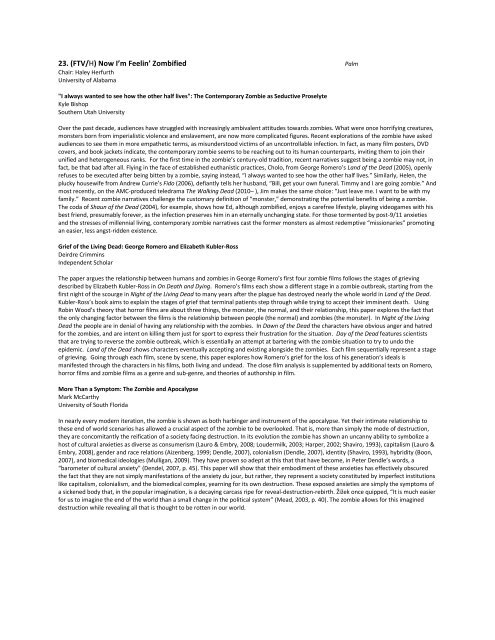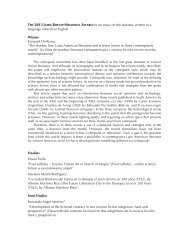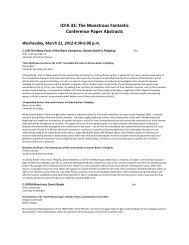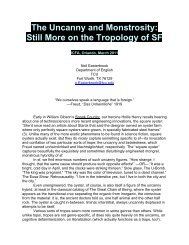22. (FTV) Cult Monsters: Rabbits, Robots, and Revenants CypressChair: Isabella van ElferenUtrecht UniversityA Leap of Imagination: <strong>The</strong> <strong>Monstrous</strong> Rabbits of Night of the LepusKatherine A. FowkesHigh Point UniversityArguably one of the worst movies ever, Night of the Lepus is one of those films that’s so bad it’s funny. Ostensibly operating in the tradition ofsci-fi/horror films that feature plagues of super-sized critters, here giant carnivorous rabbits roam the land terrorizing the locals. Seguing fromlast year’s conference on the ridiculous to this year’s on the monstrous, this paper will explore the monstrous rabbits in the context of bothhorror and humor. Could the concept have succeeded as horror with a better script or better special effects? Or does the very notion ofmonster rabbits doom the film to ridicule? By one definition, the rabbits are monstrous simply by being impossibly large. While rabbits areusually characterized as being cute or scared, scary movie rabbits DO exist (Donnie Darko, for example). But while rabbits have indeed inspiredfear in certain cultures-- most notably when associated with witchcraft, current associations are usually of innocence and vulnerability. Thisassociation creates humor in Monty Python and the Holy Grail where the incongruity between our assumptions that rabbits are cute andharmless collides with the image of a rabid-rabbit-assault. Comparing the humorous Chewbacca in Star Wars to similar creatures in successfulhorror movies, Noel Carroll writes that creatures become monstrous in part through the reaction of the other characters. Yet in this film,despite the horrified response of the characters to these giant predators, the rabbits fail to meet another of Carroll’s monster criteria: filmfootage of real grass-munching rabbits is just not that disgusting or repulsive. If monsters are also examples of phenomena gone impossiblywrong, or alternately creatures cast as repressed or vilified “Others,” (see Biskind, Cohen, Wood, for example) then the rabbits in this film are(ironically) monstrous precisely because they are monstrously inappropriate villains for a horror film.Robot Monster and the Science Fiction Cult FilmJ. P. TelotteGeorgia TechAs Lincoln Geraghty reminds us, early 1950s science fiction cinema, typified by films like <strong>The</strong> Day the Earth Stood Still (1951), <strong>The</strong> Thing (1951),Invaders from Mars (1953), and War of the Worlds (1953), typically “presented America and the world in the grip of emergencies—emergenciesthat jeopardized the future of the [human] race” (23). And the “emergency” visions in the film he cites did assert a serious purpose and raise alevel of awareness, as they prompted audiences to contemplate the trajectory of their newly atomic-driven world, to reconsider the strainedand potentially destructive relations between nations, or simply, as <strong>The</strong> Thing urged viewers, to “watch the skies, keep watching the skies” forpossible threats—from aliens, both extraterrestrial and earthly. Yet other films of the era, works like Plan 9 from Outer Space (1959), Cat-Women of the Moon (1953), and Robot Monster (1953)—all of which also invoked the specter of invasion, monsters, and apocalypticdestruction—moved viewers in rather different ways. While tracking many of the same concerns and anxieties of the era, these works and theirmonstrous visitors prompted, both then and now, a less serious, at times even laughing response—albeit one that suggests a kinship betweenthe film groups. As most readily recognize, works like Plan 9 from Outer Space, Cat-Women of the Moon, and Robot Monster are cult films,works that have a special following and special appeal, even if mainly as camp texts. Yet thanks to such key verbal indicators as “space,”“moon,” and “robot,” we also quickly recognize their science fictional status, as works that draw much of their identity from the way they treatscience, technology, and reason, the triad at the film genre’s heart. In fact, a great many science fiction films have attained a similar status,found their own cult reputation and following, works like <strong>The</strong> Phantom Empire (1935), Attack of the 50 Foot Woman (1958), Santa ClausConquers the Martians (1964), Zardoz (1974), <strong>The</strong> Rocky Horror Picture Show (1975), <strong>The</strong> Man Who Fell to Earth (1976), even a recent film likeSerenity (2005). <strong>The</strong>y have done so, I would suggest, not because they are bad or campy films—although several answer to both charges—butrather, at least in part, because of their science fiction identity and thus because of a similarity between the science fictional and the cult interms of their thrust, their narrative, and their audience appeal.From Gunfighters to the Living Dead: <strong>The</strong> Western Revitalized as the Zombie FilmLokke HeissIndependent Scholar<strong>The</strong> concept of the paper takes its cue from the seminal work of film historian Richard Slotkin, in particular his book about the Western titledGunfighter Nation. Sloktkin's thesis is that for about sixty years, Western genre became the most important pop culture forum in attempting tocreate a national mythology...a forum that tried to explain or discuss race, miscegenation, and regeneration through violence. Slotkin'sconclusion is that the genre as a central American mythology fell apart in the mid-70s, in part due to its failure to encompass or explain thefailure of the Vietnam War. My contention is that the Western genre split into fragments, partly turning to space opera (Star Wars) and partlyfinding its issues of race and identity in the films that would become 'the zombie film,' a new genre that is finding more traction every year. Ithink the zombie film has taken over the role of the Western, and would discuss how the TV show Walking Dead is this decade's version ofBonanza.
23. (FTV/H) Now I’m Feelin’ Zombified PalmChair: Haley HerfurthUniversity of Alabama"I always wanted to see how the other half lives": <strong>The</strong> Contemporary Zombie as Seductive ProselyteKyle BishopSouthern Utah UniversityOver the past decade, audiences have struggled with increasingly ambivalent attitudes towards zombies. What were once horrifying creatures,monsters born from imperialistic violence and enslavement, are now more complicated figures. Recent explorations of the zombie have askedaudiences to see them in more empathetic terms, as misunderstood victims of an uncontrollable infection. In fact, as many film posters, DVDcovers, and book jackets indicate, the contemporary zombie seems to be reaching out to its human counterparts, inviting them to join theirunified and heterogeneous ranks. For the first time in the zombie’s century-old tradition, recent narratives suggest being a zombie may not, infact, be that bad after all. Flying in the face of established euthanistic practices, Cholo, from George Romero’s Land of the Dead (2005), openlyrefuses to be executed after being bitten by a zombie, saying instead, “I always wanted to see how the other half lives.” Similarly, Helen, theplucky housewife from Andrew Currie’s Fido (2006), defiantly tells her husband, “Bill, get your own funeral. Timmy and I are going zombie.” Andmost recently, on the AMC-produced teledrama <strong>The</strong> Walking Dead (2010– ), Jim makes the same choice: “Just leave me. I want to be with myfamily.” Recent zombie narratives challenge the customary definition of “monster,” demonstrating the potential benefits of being a zombie.<strong>The</strong> coda of Shaun of the Dead (2004), for example, shows how Ed, although zombified, enjoys a carefree lifestyle, playing videogames with hisbest friend, presumably forever, as the infection preserves him in an eternally unchanging state. For those tormented by post-9/11 anxietiesand the stresses of millennial living, contemporary zombie narratives cast the former monsters as almost redemptive “missionaries” promotingan easier, less angst-ridden existence.Grief of the Living Dead: George Romero and Elizabeth Kubler-RossDeirdre CrimminsIndependent Scholar<strong>The</strong> paper argues the relationship between humans and zombies in George Romero’s first four zombie films follows the stages of grievingdescribed by Elizabeth Kubler-Ross in On Death and Dying. Romero’s films each show a different stage in a zombie outbreak, starting from thefirst night of the scourge in Night of the Living Dead to many years after the plague has destroyed nearly the whole world in Land of the Dead.Kubler-Ross’s book aims to explain the stages of grief that terminal patients step through while trying to accept their imminent death. UsingRobin Wood’s theory that horror films are about three things, the monster, the normal, and their relationship, this paper explores the fact thatthe only changing factor between the films is the relationship between people (the normal) and zombies (the monster). In Night of the LivingDead the people are in denial of having any relationship with the zombies. In Dawn of the Dead the characters have obvious anger and hatredfor the zombies, and are intent on killing them just for sport to express their frustration for the situation. Day of the Dead features scientiststhat are trying to reverse the zombie outbreak, which is essentially an attempt at bartering with the zombie situation to try to undo theepidemic. Land of the Dead shows characters eventually accepting and existing alongside the zombies. Each film sequentially represent a stageof grieving. Going through each film, scene by scene, this paper explores how Romero’s grief for the loss of his generation’s ideals ismanifested through the characters in his films, both living and undead. <strong>The</strong> close film analysis is supplemented by additional texts on Romero,horror films and zombie films as a genre and sub-genre, and theories of authorship in film.More Than a Symptom: <strong>The</strong> Zombie and ApocalypseMark McCarthyUniversity of South FloridaIn nearly every modern iteration, the zombie is shown as both harbinger and instrument of the apocalypse. Yet their intimate relationship tothese end of world scenarios has allowed a crucial aspect of the zombie to be overlooked. That is, more than simply the mode of destruction,they are concomitantly the reification of a society facing destruction. In its evolution the zombie has shown an uncanny ability to symbolize ahost of cultural anxieties as diverse as consumerism (Lauro & Embry, 2008; Loudermilk, 2003; Harper, 2002; Shaviro, 1993), capitalism (Lauro &Embry, 2008), gender and race relations (Aizenberg, 1999; Dendle, 2007), colonialism (Dendle, 2007), identity (Shaviro, 1993), hybridity (Boon,2007), and biomedical ideologies (Mulligan, 2009). <strong>The</strong>y have proven so adept at this that that have become, in Peter Dendle’s words, a“barometer of cultural anxiety” (Dendel, 2007, p. 45). This paper will show that their embodiment of these anxieties has effectively obscuredthe fact that they are not simply manifestations of the anxiety du jour, but rather, they represent a society constituted by imperfect institutionslike capitalism, colonialism, and the biomedical complex, yearning for its own destruction. <strong>The</strong>se exposed anxieties are simply the symptoms ofa sickened body that, in the popular imagination, is a decaying carcass ripe for reveal-destruction-rebirth. Žižek once quipped, “It is much easierfor us to imagine the end of the world than a small change in the political system” (Mead, 2003, p. 40). <strong>The</strong> zombie allows for this imagineddestruction while revealing all that is thought to be rotten in our world.
- Page 4 and 5: 5. (F) Wondrous Bodies of the Gende
- Page 6 and 7: Fantastic Suicide: Reading the Unca
- Page 8: Viral Posthumanism: Boundaries and
- Page 11 and 12: The Concept of Soul Divisibility in
- Page 13 and 14: Thursday, March 22, 2012 10:30 a.m.
- Page 15: 21. (CYA) Terrifying Futures: Post-
- Page 19 and 20: Fight Club: Amalgam of the Horrific
- Page 21 and 22: Taking the Monsters out of the Clos
- Page 23 and 24: Kaspar J. SaxenaIndependent Scholar
- Page 25 and 26: 44. (CYA) The Monstrosity of Teenag
- Page 27 and 28: 46. (FTV/SF) Monstrous Spin-offs: T
- Page 29 and 30: 49. (F) Aspects of Miéville Captiv
- Page 31 and 32: 53. (SF) War and Crisis in 1940s an
- Page 33 and 34: Abuse of Power: An Evolutionary Res
- Page 35 and 36: Disappearing Natives: The Colonized
- Page 37 and 38: 60. (H/IF) Ancient and Medieval Mon
- Page 39 and 40: 62. (F) The Works of Tolkien Captiv
- Page 41 and 42: 67. (SF) Imperial and Postcolonial
- Page 43 and 44: Beheading the Gorgon: Beautifying C
- Page 45 and 46: 71. (VPA) Monstrous Music MagnoliaC
- Page 47 and 48: 73. (F/IF) Portraying New Worlds Ca
- Page 49 and 50: Friday, March 23, 2012 2:45-3:45 pm
- Page 51 and 52: 81. (FTV) Those Damn Dirty Apes! Cy
- Page 53 and 54: Friday, March 23, 2012 4:00-5:30 pm
- Page 55 and 56: 92. (F) Leaving the Demonized Other
- Page 57 and 58: 94. (FTV/CYA) Monstrosity and Devia
- Page 59 and 60: of cannibalism, ghostly seduction i
- Page 61 and 62: Saturday March 24, 2012 8:30-10:00
- Page 63 and 64: 104. (CYA) Classic Monsters, Reinte
- Page 65 and 66: 107. (VPA) Monstrous Gaming Bodies
- Page 67 and 68:
who challenge the order that the Br
- Page 69 and 70:
Reading Between the Times: A Critic
- Page 71 and 72:
117. (FTV) Monsters and Superheroes
- Page 73 and 74:
119. (IF/H/PCS) International Mash-
- Page 75 and 76:
Focusing on Stoker's Dracula as one
- Page 77 and 78:
Florida Atlantic UniversitySheri S.
- Page 79 and 80:
Simmons CollegeIn the spate of rece
- Page 81 and 82:
Independent ScholarKing’s story
- Page 83 and 84:
modernity opens up for every indivi
- Page 85 and 86:
Saturday March 24, 2012 4:00-5:30 p
- Page 87 and 88:
141. (FTV) Monstrous Masculinity Cy
- Page 89 and 90:
ultimately make peace with her mons
- Page 91 and 92:
where the almost-human sentient zom





